Sequence viewing > Index - Cameras - lenses - optics - Resource - ©
Lloyd Godman
Film - Digital
What
is the speed of a lens?
The
speed of a lens depends upon the maximum amount of light it
is capable of transmitting through to the film. This speed
rating is determined by the diameter of the lens and the distance
the light travels from the lens to the focal plane or film,
and is measured in f stops. Sometimes this is also talked
about as how fast a lens is.
It
relates to the widest or most open aperture that the lens
has. Because
the exposure is a combination of both shutter speed and the
lens aperture, and having a faster lens or wider aperture
allows more light through the lens, a photographer can work
hand held with out camera shake in dimmer conditions.
Although we don't usually use the widest aperture for most
shooting, with 35 mm SLR cameras it is useful to have
a bright viewing screen so faster lenses are of benift when
we view the image before we push the shutter, - this extra
light provides better illumination to focus the image.
However
- faster lenses mean larger pieces of optical glass and while
they have the potential to allow more light through the lens,
because of the extra glass, they cost more $$. So a photographer
needs to assess if they need to spend the $$ on the extra
speed.
| A range
of similar lenses of differing speeds might be manufactured
as follows:
50
mm f1.2
50 mm f1.4
50 mm f2
50 mm f2.8 |

The speed of the lens is usually imprinted around
the face of the lens, and in the image above it is
imprinted in the lower right corner as 1:2 |
This
means that when a subject is photographed at size on the negative
smaller than a ratio of 1 to 1 f 2 is the fastest
aperture of this lens, if however the ratio is larger than
1 to 1 the aperture setting ill be untrue and will have
to be calculated. Hence the embossing 1:2
Want to learn more? - do a workshop or one on one with Lloyd Godman
|